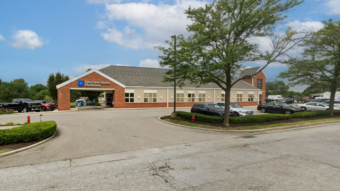The pace of change within the American office has quickened over the past 10 years. Not just in the technology that people use, but also in how that technology unyokes them within the workspace. Building owners and managers who aren’t paying attention may be left behind.
“If you walk into an office today, you’ll probably notice that there aren’t a lot of tenants with desk phones in their spaces,” said Christine Torres. “They’re all operating off of their cell phones or over VOIP. And the days of having your computer physically plugged into the ethernet are long gone.”
Torres is head of Chicago at WiredScore, an organization that rates the technological capacity within commercial buildings. She will also be speaking at the 3rd annual State of the Suburban Market Conference on September 20th at the Schaumburg Corporate Center. Click here to find out more or to register for this conference.
As employees today largely work on laptops and over Wi-Fi, this literal untethering from a desk frees them to work is spots such as an office’s kitchen area, conference room or huddle spaces. Many are also using cell phones as their sole conduit for making company calls.
“A lot of companies have BYOD policies—bring your own device,” said Torres.
This increasing reliance on wireless technology means that a search for office space doesn’t end with standard specs like square footage and rental terms. Shrewd tenants also want to know how secure and reliable a building’s wireless capabilities are.
The internet has become a utility, as necessary to day-to-day life as water or power. It would follow, therefore, that an office tenant on the hunt for new digs could assume that virtually any Class A or even Class B space will have reliable and secure network access. But that’s not always the case.
WiredScore got its start in New York five years ago. As Silicon Valley companies sought access to East Coast capital, these sophisticated, knowledgeable firms became frustrated when they couldn’t get straight answers about the telecom infrastructure within the buildings they were looking at.
The answer was certification. Knowing upfront what is and is not available will prevent companies and their employees from suffering volatile Wi-Fi or unpredictable mobile coverage.
“Tenants are getting smarter about the connectivity needs and the requirements they have on their end,” said Torres. “The real estate industry needs to respond to that and be able to concisely communicate the systems that they have in place.”
While high-tech firms may have been the genesis for better transparency in building connectivity, it’s an issue that affects companies of all stripes. Irrespective of the industry they serve, no office can survive without dependable email, accessible network drives or saving in the cloud.
“Tenants’ evolving tech needs means that they are all tech tenants,” Torres said. “Whether they are a growing internet company or a large financial services firm or even a small, family law office, every company and every organization is reliant on technology.”
Security within connectivity systems is also important and today’s buildings are constructed with multiple redundancies, meaning less likelihood of a network outage or dropped cell coverage. A recent study found that office tenants reported increased stress levels and lower productivity when connectivity issues interrupt their work.
Because of this, more than three-quarters of leasing decision makers confirm that poor connectivity impacts the company’s profitability. Quality of internet has thus become their second-highest priority after location when searching for office space.
This demand has led to well-connected office spaces commanding higher rents. WiredScore recently collaborated on a review of rents within the New York market. In a comparison between Wired-Certified buildings versus peer buildings lacking certification, there was an average 7 percent rent premium across various Class A and B buildings.
“Based on that data, I think it’s safe to infer that owners who are consistently investing in their information infrastructure, and are marketing and branding that infrastructure, are able to see a better return on investment,” said Torres.
In June, WiredScore expanded into Chicago, establishing it as a flagship market. Among the launch partners who have committed to Wired Certification for Chicago office properties were 601W Companies, Ascentris, Beacon Capital Partners, EQ Office, Farpoint Development, GlenStar Asset Management, Golub & Company, Hines, The John Buck Company, KBS, Mark Goodman & Associates Inc., MetLife Investment Management, Riverside Investment & Development Company, Walton Street Capital and Zeller Realty Group.
These and other firms control marquee office assets in the Chicago metro. Willis Tower, 150 N. Riverside Plaza, AMA Plaza and 1 North Dearborn are all among Chicago’s platinum-certified buildings. And it’s not just in the Loop, as Farpoint’s 6300 River Road in Rosemont is a suburban example of a property committed to Wired Certification.
Future-proofing an office space, whether new construction or redevelopment, should always be a concern. But as technology progresses so rapidly, it can be tough to keep up. When developers begin a project, they may not see the fruits of those labors for several years, well into the next cycle of technological advancement.
“It is paramount to understand what systems are currently in a building,” said Torres. “Knowing what providers are currently in place and who’s in the area, even if they’re not in the building, will help to prioritize these future-proofing initiatives.”
New technologies offer freedom and productivity to office workers, who have eagerly adopted every advancement. If building owners and operators want to stay relevant and competitive, they must be sensitive to changing landscape of information infrastructure.



